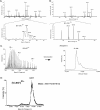Principles of electrospray ionization
- PMID: 21742801
- PMCID: PMC3134074
- DOI: 10.1074/mcp.M111.009407
Principles of electrospray ionization
Abstract
Electrospray ionization is today the most widely used ionization technique in chemical and biochemical analysis. Interfaced with a mass spectrometer it allows the investigation of the molecular composition of liquid samples. With electrospray a large variety of chemical substances can be ionized. There is no limitation in mass which thus enables even the investigation of large noncovalent protein complexes. Its high ionization efficiency profoundly changed biomolecular sciences because proteins can be identified and quantified on trace amounts in a high throughput fashion. This review article focuses mainly on the exploration of the underlying ionization mechanism. Some ionization characteristics are discussed that are related to this mechanism. Typical spectra of peptides, proteins, and noncovalent complexes are shown and the quantitative character of spectra is highlighted. Finally the possibilities and limitations in measuring the association constant of bivalent noncovalent complexes are described.
Figures





Similar articles
-
Principles of electrospray ionization.Mol Cell Proteomics. 2011 May 19. doi: 10.1074/mcp.R111.009407. Online ahead of print. Mol Cell Proteomics. 2011. PMID: 21597042
-
Detection of noncovalent complex between alpha-amylase and its microbial inhibitor tendamistat by electrospray ionization mass spectrometry.Rapid Commun Mass Spectrom. 2001;15(2):89-96. doi: 10.1002/1097-0231(20010130)15:2<89::AID-RCM195>3.0.CO;2-1. Rapid Commun Mass Spectrom. 2001. PMID: 11180535
-
Study on the noncovalent interactions of antiepileptic drugs and amyloid β 1-40 peptide by electrospray ionization mass spectrometry.Rapid Commun Mass Spectrom. 2012 Oct 15;26(19):2372-6. doi: 10.1002/rcm.6328. Rapid Commun Mass Spectrom. 2012. PMID: 22956330 No abstract available.
-
A review on the interrogation of peptide-metal interactions using electrospray ionization-mass spectrometry.Anal Chim Acta. 2011 Feb 7;686(1-2):19-39. doi: 10.1016/j.aca.2010.11.050. Epub 2010 Dec 5. Anal Chim Acta. 2011. PMID: 21237305 Review.
-
The synergy of elemental and biomolecular mass spectrometry: new analytical strategies in life sciences.Chem Soc Rev. 2009 Jul;38(7):1969-83. doi: 10.1039/b618635c. Epub 2009 Apr 16. Chem Soc Rev. 2009. PMID: 19551177 Review.
Cited by
-
Application of nanomaterials in proteomics-driven precision medicine.Theranostics. 2022 Mar 6;12(6):2674-2686. doi: 10.7150/thno.64325. eCollection 2022. Theranostics. 2022. PMID: 35401834 Free PMC article. Review.
-
A novel method for textile odor removal using engineered water nanostructures.RSC Adv. 2019 Jun 5;9(31):17726-17736. doi: 10.1039/c9ra01988j. eCollection 2019 Jun 4. RSC Adv. 2019. PMID: 35520538 Free PMC article.
-
Valet Parking for Protein Ion Charge State Concentration: Ion/Molecule Reactions in Linear Ion Traps.Anal Chem. 2020 Apr 7;92(7):5419-5425. doi: 10.1021/acs.analchem.0c00146. Epub 2020 Mar 9. Anal Chem. 2020. PMID: 32100997 Free PMC article.
-
Species-specific optimization of oxylipin ionization in LC-MS: a design of experiments approach to improve sensitivity.Anal Bioanal Chem. 2025 Apr;417(9):1807-1818. doi: 10.1007/s00216-025-05759-6. Epub 2025 Feb 1. Anal Bioanal Chem. 2025. PMID: 39891659 Free PMC article.
-
Proteomics: from single molecules to biological pathways.Cardiovasc Res. 2013 Mar 15;97(4):612-22. doi: 10.1093/cvr/cvs346. Epub 2012 Nov 23. Cardiovasc Res. 2013. PMID: 23180722 Free PMC article. Review.
References
-
- Karas M., Hillenkamp F. (1988) Laser desorption ionization of proteins with molecular masses exceeding 10,000 daltons. Anal. Chem. 60, 2299–2301 - PubMed
-
- Meng C. K., Mann M., Fenn J. (1988) Of protons or proteins. Zeitschrift für Physik D Atoms, Molecules and Clusters 10, 361–368
-
- Fenn J. B., Mann M., Meng C. K., Wong S. F., Whitehouse C. M. (1989) Electrospray ionization for mass spectrometry of large biomolecules. Science 246, 64–71 - PubMed
-
- Taylor G. (1964) Disintegration of water drops in an electric field. Proc. R. Soc. Lon. A 280, 383–397
-
- Dole M., Mack L. L., Hines R. L., Mobley R. C., Ferguson L. D., Alice M. B. (1968) Molecular beams of macroions. J. Chem. Phys. 49, 2240–2249
Publication types
MeSH terms
Substances
LinkOut - more resources
Full Text Sources
Other Literature Sources

